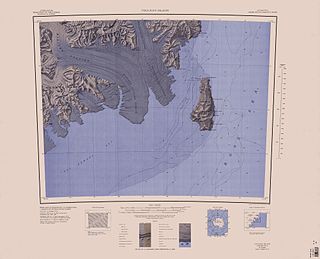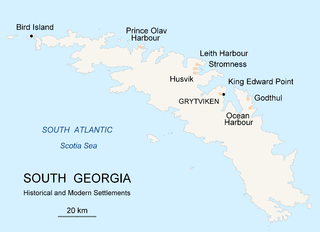
Borchgrevink Glacier is a large glacier in the Victory Mountains, Victoria Land, draining south between Malta Plateau and Daniell Peninsula, and thence projecting into Glacier Strait, Ross Sea, as a floating glacier tongue, the Borchgrevink Glacier Tongue, just south of Cape Jones. It was named by the New Zealand Geological Survey Antarctic Expedition, 1957–58, for Carsten Borchgrevink, leader of the British Antarctic Expedition, 1898–1900. Borchgrevink visited the area in February 1900 and first observed the seaward portion of the glacier.

Prince Olav Harbour is a small harbour in the south west portion of Cook Bay, entered between Point Abrahamsen and Sheep Point, along the north coast of South Georgia.
Hindle Glacier is a glacier 6 miles (10 km) long, flowing north from the vicinity of Mount Paterson into Royal Bay on the north coast of South Georgia. It was surveyed by the South Georgia Survey (SGS), 1951–52. The name "Bruce Glacier" was used unofficially by the British South Georgia Expedition, 1954–55, but a number of Antarctic features are named for Dr. William S. Bruce. The UK Antarctic Place-Names Committee recommended in 1957 that the glacier be named for Dr. Edward Hindle, a British zoologist who, as Honorary Secretary of the Royal Geographical Society, was of great assistance to the SGS expeditions.
The Samuel Islands are a group of small islands and rocks lying close to the south coast of South Georgia, 1.6 km west-southwest of Nilse Hullet and 3.2 km east-southeast of Klutschak Point. Surveyed by the SGS in the period 1951–57. Named by the United Kingdom Antarctic Place-Names Committee (UK-APC) after the catcher Don Samuel, built in 1925 and later owned by the Compania Argentina de Pesca, Grytviken, which sank in the vicinity of these islands in 1951.
Crean Glacier is a glacier 4 miles (6.4 km) long, flowing northwest from Wilckens Peaks to the head of Antarctic Bay on the north coast of South Georgia. It was surveyed by the South Georgia Survey in the period 1951–57 and named by the UK Antarctic Place-Names Committee for Irishman Tom Crean, Second Officer of the Endurance during the British expedition under Ernest Shackleton, 1914–16. Crean accompanied Shackleton and Frank Worsley in the James Caird from Elephant Island to King Haakon Bay, South Georgia, and made the overland crossing with them to Stromness; this glacier lies on the route.
Goldcrest Point is the northwest point of Bird Island, South Georgia, with Payne Creek just south of it. It was charted by Discovery Investigations personnel on the Discovery in the period 1926–30 and by the South Georgia Survey, 1951–57. The point is the site of a large colony of Macaroni penguins. The name, given by the UK Antarctic Place-Names Committee in 1963, refers to the golden crests of this species.
Graae Glacier is a glacier 2 miles (3 km) long on the north side of Mount Sabatier, flowing west-southwest to Trollhul in the south part of South Georgia. It was surveyed by the South Georgia Survey (SGS) in the period 1951–57, and named by the UK Antarctic Place-Names Committee for Mogens E.W. Graae of Denmark, who developed sledges for the SGS, 1953–54 and 1955–56.
Briggs Glacier is a glacier between Mount Worsley and The Trident in central South Georgia, flowing northwest into Murray Snowfield. It was charted as a glacier flowing into the head of Possession Bay in 1929 by Lieutenant Commander John M. Chaplin, Royal Navy (1888–1977). Chaplin was survey officer aboard RRS Discovery during the Discovery Oceanographic Expedition of 1925–1927, and was later in charge of a hydrographic survey party in South Georgia, 1928–30.
Lancing Glacier is a glacier 3 nautical miles (6 km) long, flowing south from Mount Corneliussen and Smillie Peak to Newark Bay on the south side of South Georgia. It was surveyed by the South Georgia Survey in the period 1951–57, and named by the UK Antarctic Place-Names Committee for the Lancing, built in 1898, and converted to a whale factory ship in 1923. It was the first factory ship to be fitted with a slipway.
Morris Glacier is a glacier flowing north to the head of Sea Leopard Fjord in the Bay of Isles, South Georgia. it was charted in 1912–13 by American naturalist Robert Cushman Murphy, aboard the brig Daisy, who named it for Edward Lyman Morris, a botanist who was then head of the Department of Natural Science at the Brooklyn Museum.
Archer Glacier is a glacier flowing northwest into the head of Bolson Cove, Flandres Bay, on the west coast of Graham Land.
Binary Peaks is a steep pinnacle covered with snow with two snow free and therefore conspicuous summits, situated 1.5 nautical miles (3 km) northwest of Mount Krokisius and 2 nautical miles (4 km) north-northwest of Moltke Harbor, South Georgia. This feature was named "Doppelspitz" by a German expedition under K. Schrader, 1882–83, and was identified by the British Combined Services Expedition of 1964–65. An English form of the name, Binary Peaks, was recommended by the UK Antarctic Place-Names Committee in 1971.
Binnie Peaks are twin peaks rising to 430 metres (1,410 ft) to the north of Romerof Head in western South Georgia. Named by the UK Antarctic Place-Names Committee after Edward Beveridge Binnie, second British resident magistrate, South Georgia, 1915–26, succeeding James Innes Wilson.
Blechnum Peaks are three peaks, the highest 640 metres (2,100 ft) high, on the north–south ridge between Gulbrandsen Lake and Olsen Valley on the north coast of South Georgia. They were named by the UK Antarctic Place-Names Committee, following British Antarctic Survey biological work in the area, after the rare fern Blechnum penna-marina, whose occurrence in South Georgia is known only from the north and east slopes of these peaks and from the adjacent Olsen Valley.
Murphy Wall is a series of north–south trending peaks, the highest 905 m, resembling a wall along the west side of Grace Glacier on the north side of South Georgia. Surveyed by the South Georgia Survey in the period 1951–57, and named by the United Kingdom Antarctic Place-Names Committee (UK-APC) for Robert Cushman Murphy, American ornithologist who made observations and collections in the Bay of Isles in 1912-13 for the American Museum of Natural History, New York City.
Pio Point is a point forming the north side of the entrance to Johnson Cove at the west end of Bird Island, South Georgia. Roughly charted by DI personnel on the Discovery in the period 1926-30 and surveyed by HMS Owen in 1960–61. Named by the United Kingdom Antarctic Place-Names Committee (UK-APC) in 1963. "Pio" is an old sailors' name for the light-mantled sooty albatross, a bird which breeds on Bird Island.
Morse Point is a point marking the east side of the entrance of Antarctic Bay on the north coast of South Georgia. The point appears roughly charted on maps dating back to about 1900; it was roughly surveyed by Discovery Investigations personnel in the period 1925–31, and resurveyed by the South Georgia Survey in 1951–52. The point was named by the UK Antarctic Place-Names Committee after the British sealing vessel Morse, which was working in South Georgia in 1799–1800, probably the first British sealer to do so. She was based at Antarctic Bay when encountered by Edmund Fanning, who published an account of the meeting.
Hay Peak is a peak rising to 660 metres (2,170 ft) at the head of Prince Olav Harbour in Cook Bay, South Georgia. It was charted and descriptively named "The Snow Pap" by the Discovery Investigations in 1929, but subsequently deleted. It was renamed Hay Peak by the UK Antarctic Place-Names Committee in 1990 after Arthur E. Hay of Somerset, England, who was Technical Engineer with the Southern Whaling and Sealing Company at its whaling station at Prince Olav Harbour, 1924–35.
Klutschak Point is a rocky point 2 nautical miles (4 km) southeast of Cape Demidov on the south coast of South Georgia. The coast in this vicinity was roughly charted in 1775 by a British expedition under James Cook and in 1819 by a Russian expedition under Fabian Gottlieb von Bellingshausen. The point itself appears on charts dating back to about 1900. It was named by the UK Antarctic Place-Names Committee following a survey by the South Georgia Survey, 1951–52, for Heinrich W. Klutschak, an Austrian artist who accompanied the American sealing schooner Flying Fish to South Georgia in 1877–78 and published a narrative of his activities with a sketch map in 1881.
McCarthy Island is an island, 1 nautical mile (2 km) long, lying in the entrance to King Haakon Bay on the south side of South Georgia. It was surveyed by the South Georgia Survey in the period 1951–57, and was named by the UK Antarctic Place-Names Committee after Timothy McCarthy, a seaman on the Endurance during the British expedition under Ernest Shackleton, 1914–16. McCarthy accompanied Shackleton in the James Caird from Elephant Island to King Haakon Bay.
![]() This article incorporates public domain material from "The Trident". Geographic Names Information System . United States Geological Survey.
This article incorporates public domain material from "The Trident". Geographic Names Information System . United States Geological Survey. 
